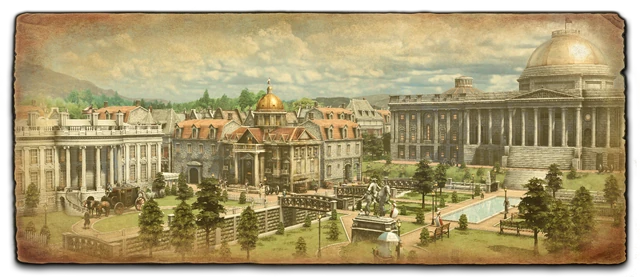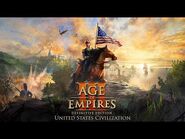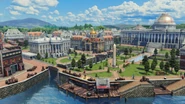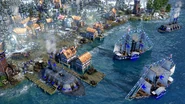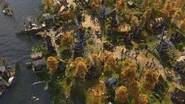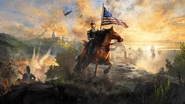| This article is about the playable expansion civilization. For other uses, see United States (disambiguation). |
| “ | The "land of opportunity" provided a new world for people from many nations, creating the famous melting pot of cultures. Expanding from militia forces skilled in skirmishing tactics and marksmanship to a professional army, the United States of America ensured its independence and impressive road to prosperity. | ” |
| —Forgotten Empires website | ||
The United States of America, simply known as the United States (U.S.), is a Federal American civilization introduced as DLC to Age of Empires III: Definitive Edition.
Player access to the United States can be purchased on Steam or the Microsoft Store. It could previously be unlocked for free by completing limited-time challenges based on the present-day fifty American states.
Note that the playable United States civilization is distinct from the United States (campaign) civilization encountered or portrayed in the campaigns Act II: Ice, Act III: Steel, and Act II: Shadow.
Home City[]
- Default General names
- Alexander Hamilton, Alexander McDougall, Anthony Wayne, Artemas Ward, Baron Von Steuben, Benedict Arnold, Benjamin Lincoln, Charles Lee, Daniel Morgan, Francis Marion, George Custer, Henry Knox, Horatio Gates, Israel Putnam, Jacob Jennings Brown, Jean-Baptiste Rochambeau, Johann de Kalb, John Cadwalader, John Sullivan, Joseph Hooker, Julius A. Penn, Louis Duportail, Marquis de Lafayette, Nathanael Greene, Philip Sheridan, Richard B. Paddock, Samuel Holden Parsons, Stephen W. Kearny, Thaddeus Kościuszko, Ulysses S. Grant, William Alexander, William Eaton, William Henry Harrison, William Moultrie, William Sherman, William Smallwood, Winfield Scott, Zachary Taylor
 Star-Spangled Banner Flags - Display the Star-Spangled Banner flag on this building (Default)
Star-Spangled Banner Flags - Display the Star-Spangled Banner flag on this building (Default) Betsy Ross Flag - Display the Betsy Ross flag on this building (1 point)
Betsy Ross Flag - Display the Betsy Ross flag on this building (1 point) Grand Union Flag - Display the Grand Union flag on this building (1 point)
Grand Union Flag - Display the Grand Union flag on this building (1 point) Bunting Flag - Display bunting flag on this building (1 point)
Bunting Flag - Display bunting flag on this building (1 point) Market Stalls - Display market stalls in front of the White House (1 point)
Market Stalls - Display market stalls in front of the White House (1 point) The Royal Coach - This coach waits upon the whims of royalty (1 point)
The Royal Coach - This coach waits upon the whims of royalty (1 point) The Artist - An artist who sets up his easel and paints (1 point)
The Artist - An artist who sets up his easel and paints (1 point) The Reverend - A street preacher sharing the good news (1 point)
The Reverend - A street preacher sharing the good news (1 point) Mime - A street performer who interacts with an unseen world (1 point)
Mime - A street performer who interacts with an unseen world (1 point)
 Star-Spangled Banner Flags - Display the Star-Spangled Banner flag on this building (Default)
Star-Spangled Banner Flags - Display the Star-Spangled Banner flag on this building (Default) Betsy Ross Flag - Display the Betsy Ross flag on this building (1 point)
Betsy Ross Flag - Display the Betsy Ross flag on this building (1 point) Grand Union Flag - Display the Grand Union flag on this building (1 point)
Grand Union Flag - Display the Grand Union flag on this building (1 point) Bunting Flag - Display bunting flag on this building (1 point)
Bunting Flag - Display bunting flag on this building (1 point) Academy Guards - Guards standing guard in front of the Academy (1 point)
Academy Guards - Guards standing guard in front of the Academy (1 point) Academy (original) - The original version of the Academy (Default)
Academy (original) - The original version of the Academy (Default) Academy (copper) - A white version of the Academy with bright copper roofing (1 point)
Academy (copper) - A white version of the Academy with bright copper roofing (1 point) Academy (green) - A white version of the Academy with green roofing (1 point)
Academy (green) - A white version of the Academy with green roofing (1 point)
 Daytime Lighting - The city with the sun shining brightly (Default)
Daytime Lighting - The city with the sun shining brightly (Default) Dusk Lighting - The city at dusk (1 point)
Dusk Lighting - The city at dusk (1 point) Night Lighting without fireworks - The city at night (1 point)
Night Lighting without fireworks - The city at night (1 point) Night Lighting - The city at night with spectacular fireworks (1 point)
Night Lighting - The city at night with spectacular fireworks (1 point) Star-Spangled Banner Flags - Display the Star-Spangled Banner flag on this building (Default)
Star-Spangled Banner Flags - Display the Star-Spangled Banner flag on this building (Default) Betsy Ross Flag - Display the Betsy Ross flag on this building (1 point)
Betsy Ross Flag - Display the Betsy Ross flag on this building (1 point) Grand Union Flag - Display the Grand Union flag on this building (1 point)
Grand Union Flag - Display the Grand Union flag on this building (1 point) Bunting Flag - Display bunting flag on this building (1 point)
Bunting Flag - Display bunting flag on this building (1 point) Cannons - Display cannons at the Capitol (1 point)
Cannons - Display cannons at the Capitol (1 point) Cherry Trees - Display cherry trees in front of the Capitol Building (1 point)
Cherry Trees - Display cherry trees in front of the Capitol Building (1 point) Bald eagle - A soaring bald eagle that watches the city (1 point)
Bald eagle - A soaring bald eagle that watches the city (1 point) Capitol (original) - The original version of the Capitol with copper roofing (Default)
Capitol (original) - The original version of the Capitol with copper roofing (Default) Capitol (green copper roofing) - The Capitol with green copper roofing (1 point)
Capitol (green copper roofing) - The Capitol with green copper roofing (1 point)
 Bunting Flag - Display bunting flag on this building (1 point)
Bunting Flag - Display bunting flag on this building (1 point) Cannons - Display a cannon at the Manufacturing Plant (1 point)
Cannons - Display a cannon at the Manufacturing Plant (1 point) Hotdog Man - Hotdog vendor, get your hotdogs here! (1 point)
Hotdog Man - Hotdog vendor, get your hotdogs here! (1 point) United States Manufacturing Plant (original) - The original color scheme of the United States Manufacturing Plant (Default)
United States Manufacturing Plant (original) - The original color scheme of the United States Manufacturing Plant (Default) United States Manufacturing Plant (red) - A red and gold version of the United States Manufacturing Plant (1 point)
United States Manufacturing Plant (red) - A red and gold version of the United States Manufacturing Plant (1 point) United States Manufacturing Plant (blue) - A blue and white version of the United States Manufacturing Plant (1 point)
United States Manufacturing Plant (blue) - A blue and white version of the United States Manufacturing Plant (1 point) United States Manufacturing Plant (orange) - An orange version of the United States Manufacturing Plant (1 point)
United States Manufacturing Plant (orange) - An orange version of the United States Manufacturing Plant (1 point)
 Floating Crates - Floating crates in the Harbor (1 point)
Floating Crates - Floating crates in the Harbor (1 point) Bunting Flag - Display bunting flag on this building (1 point)
Bunting Flag - Display bunting flag on this building (1 point) Cranes - Display cranes at the Harbor (1 point)
Cranes - Display cranes at the Harbor (1 point) Obelisk - Display obelisk statue at the Harbor (Default; Obelisk, Explorer Statue, and Nate Statue are in the same slot, activating one disables others)
Obelisk - Display obelisk statue at the Harbor (Default; Obelisk, Explorer Statue, and Nate Statue are in the same slot, activating one disables others) Explorer Statue - Display explorer statue at the Harbor (1 point)
Explorer Statue - Display explorer statue at the Harbor (1 point) Nate Statue - Display Nathan Black statue at the Harbor (1 point)
Nate Statue - Display Nathan Black statue at the Harbor (1 point) Swedish ships - Swedish ships docked at the Harbor (1 point)
Swedish ships - Swedish ships docked at the Harbor (1 point) Nice Lady - A woman in a red dress (1 point)
Nice Lady - A woman in a red dress (1 point)
Characteristics[]
Civilization bonuses[]
- Starts with 400 food, 200 wood, 100 XP, and six Settlers.
- Settlers have a lower train limit (90).
- Has the General as the hero unit, which can plant Inspiring Flags to augment nearby units and buildings, and build Forts instead of Town Centers.
- Levy/Conscription can be used repeatedly but with a long global cooldown between each use.
- Have access to Immigrant and Legion Home City Cards.
- "Robber Barons" and "Industrial Revolution" are automatically added to the deck in the Industrial Age.
- Choose Federal States to advance in Age and add new Home City cards to the Deck, starting with fewer cards (21) than other civilizations.
- National Guard unit: State Militia (Volunteer)
[]
 General: The hero of your civilization. Explores, fights, builds Forts and Trading Posts. Cannot die. If he falls unconscious, he can be rescued.
General: The hero of your civilization. Explores, fights, builds Forts and Trading Posts. Cannot die. If he falls unconscious, he can be rescued. Sloop: Small and nimble warship. Good at exploring, fishing or transport.
Sloop: Small and nimble warship. Good at exploring, fishing or transport. Steamer: Powerful, steam-propelled warship resistant to building fire that can train units, construct docks and gather fish.
Steamer: Powerful, steam-propelled warship resistant to building fire that can train units, construct docks and gather fish. Ironclad: Advanced armored warship.
Ironclad: Advanced armored warship.
Unique units[]
 Minuteman: Quick-training, Minuteman who quickly loses hitpoints, becoming less effective over time.
Minuteman: Quick-training, Minuteman who quickly loses hitpoints, becoming less effective over time. State Militia: Skirmisher with low range that sacrifices attack for hitpoints. Gains additional hitpoints in groups.
State Militia: Skirmisher with low range that sacrifices attack for hitpoints. Gains additional hitpoints in groups. Regular: Heavy ranged infantry with greater range than other Musketeers. Armed with a bayonet to beat cavalry.
Regular: Heavy ranged infantry with greater range than other Musketeers. Armed with a bayonet to beat cavalry. Sharpshooter: Skirmisher with a long-ranged attack, but low hitpoints. Gains extra range per upgrade. Good against infantry.
Sharpshooter: Skirmisher with a long-ranged attack, but low hitpoints. Gains extra range per upgrade. Good against infantry. Carbine Cavalry: Ranged light cavalry equipped with a carbine repeater. Good against Heavy Cavalry and Artillery.
Carbine Cavalry: Ranged light cavalry equipped with a carbine repeater. Good against Heavy Cavalry and Artillery. Gatling Gun: Early automatic-fire weapon. Better against infantry than buildings.
Gatling Gun: Early automatic-fire weapon. Better against infantry than buildings. Quaker Gun: Decoy unit which deals no damage but can take the shape of any common artillery. Good to distract the enemy and to attract enemy fire.
Quaker Gun: Decoy unit which deals no damage but can take the shape of any common artillery. Good to distract the enemy and to attract enemy fire. Gunslinger: A dangerous outlaw with a pistol. Can quickly fire 3 shots.
Gunslinger: A dangerous outlaw with a pistol. Can quickly fire 3 shots. Cowboy: A dangerous outlaw on horseback. Has a high powered shot.
Cowboy: A dangerous outlaw on horseback. Has a high powered shot. Owlhoot: A dangerous outlaw with a rifle. Can deal AoE damage in a cone in front of him.
Owlhoot: A dangerous outlaw with a rifle. Can deal AoE damage in a cone in front of him.
[]
 Saloon: Trains sinister outlaws and mercenaries.
Saloon: Trains sinister outlaws and mercenaries.
Unique buildings[]
 Meeting House: Trains healers, provides town improvements and trickles XP.
Meeting House: Trains healers, provides town improvements and trickles XP. State Capitol: Wagon training and powerful improvements for your civilization.
State Capitol: Wagon training and powerful improvements for your civilization.
Federal States[]
- Delaware, Massachusetts, Pennsylvania, Rhode Island, Virginia (Commerce Age)
- Indiana, Kentucky, Maryland, New Hampshire, Tennessee (Fortress Age)
- California, New Jersey, Ohio, South Carolina, Vermont (Industrial Age)
- Connecticut, Florida, Illinois, New York, Texas (Imperial Age)
Overview[]
Although it does not have the economic prowess of some of its European counterparts, the United States is a powerful civilization with heavy emphasis on combat. A major asset of the United States is that the civilization makes use of a wide variety of ranged gunpowder units that can inflict greater damage and even outrange other units with the proper upgrades. However, a downside of the United States' units is their emphasis of attack damage over health, such as the State Militia or the Sharpshooter, which can be problematic if swarmed by fast melee or artillery units.
One of the advantages of the United States is their ability to utilize Federal Cards. Rather than using the Politician system like its European counterparts, United States players will instead pick a Federal State that grants not just resources, units or technologies, but two unique Federal cards, reflective of the particular Federal state. The cards will be added to the Home City deck, and cannot be found when building the Home City deck prior to the game. Because of the Federal Cards system, the United States has a notably smaller deck compared to other civilizations, as players can only pick up to 21 cards as opposed to the usual 25.
The United States also have access to Immigrant cards, which grant bonuses and economic units/resources reflective of the civilizations the cards "borrow" from, as well as Legion cards which ship powerful military units and make them trainable at Forts. These cards function similar to the Consulate units and bonuses gained by the Asian civilizations.
Unlike other civilizations, the United States has the General unit, a powerful and heartier Explorer that can be used to create Trading Posts and Forts, with the drawback of being denied the capability of constructing Town Centers. It has a unique ability to plant an Inspiring Flag that makes military units perform better in combat, and makes buildings construct and train units faster.
The United States cannot revolt like European civilizations, but can access something similar to it by aging with the California federal state to the Industrial Age and shipping the Bear Flag Revolt federal card. Otherwise, it will only be given the opportunity to advance to the Imperial Age.
Campaign appearances[]
| This section needs expansion. You can help by adding to it. |
- Historical Battles
- Battle of Queenston Heights
- American Army - Enemy
- American Army - Enemy
- The Burning of USS Philadelphia
- US Volunteers - Player
- US Navy - Ally
- Battle of Queenston Heights
Further, some scenarios and campaigns use a civilization named "United States", but are different in-game and have their own separate tech tree, units, and buildings.
- Act III: Steel - All United States appearances are by United States (campaign)
- Historical Battles
- Battle of New Orleans
- United States Army - Player, using United States (scenario)
- New Orleans - Ally, also using United States (scenario)
- Battle of New Orleans
In-game dialogue[]
- Main article: United States' dialogue lines
United States units all speak contemporary North American English, with the exception of some units acquired via Home City Cards. Several of the units speak using recycled or modified voice clips originally used for campaign characters and units.
Common[]
- Select
- At attention
- Good day, sir
- Hello
- I'm ready
- Medic present
- Orders?
- Ready to fire
- What are my targets?
- Whatcha need?
- What is your command?
- Yeah?
- Yes?
- Move
- Advance
- Alright
- Consider it done
- Forward march!
- I'll do it
- I'll heal the wounded
- I'm going now
- Make ready
- Okay
- On my way
- Ready
- Right
- Right away
- Sure thing
- Yes
- Yes, sir
- Attack
- Attack!
- Fire!
- For America!
- Ho!
- I'll attack!
- I'll get 'em!
- Right!
- To arms!
- To battle!
- You got it!
Settlers[]
- Build Builder
- Build 2 Carpenter
- Farm Farmer
- Gather Coin Miner
- Gather Fruit Gatherer
- Gather Meat Hunter
- Gather Wood Lumberjack
General[]
No "Claim" line.
- Disabled I'm wounded! Fetch a medic!
- Ransomed Thank you for paying my ransom!
- Revived It'll take more than that to keep me down!
History[]
| “ | The history of the United States begins millennia ago with the indigenous peoples who migrated into the North American continent and settled throughout, creating culturally and linguistically distinct societies. The majority of these were founded on hunter-gatherer subsistence, but some also practiced agriculture and engaged in activities such as metallurgy, nautical navigation, and long-distance trade. By the time that the first European explorers reached the continent, these societies had been living in harmony with their surroundings for roughly 10,000 years. In contrast, Europeans such as the Icelanders under Leifr Eiriksson who sailed to modern-day Newfoundland c. 1000 CE failed to adapt to the local climate and thus left or disappeared. By the 15th century, Europe was undergoing a process of social and economic revolutions marked by, among other things, massive population booms and vibrant trade economies. An allure for luxury resources brought on by the taste that they had through trade partners in the Middle East spurred a desire to explore and establish settlements so as to have direct access to these resources. After Christopher Columbus stumbled upon the Caribbean islands while seeking an alternative western route to East Asia, European settlers began to flock to the so-called "New World" seeking land, wealth, and religious freedom, among other things. While a select few instances of peaceful coexistence did transpire, their interactions with the local indigenous populations were on the whole fraught with discord and friction. European settlers often treated the natives callously and seized land by force, a theme that would continue throughout the majority of the continent's history. Exposure to new and devastating diseases wiped out entire native populations and the shifting balance of power spelled the end of the lives of the indigenous peoples as they knew it. Some integrated with the expanding European settlements, but most were driven away from their ancestral homelands or died off, not least due to certain European settlers' nefarious practice of using manipulative diplomacy to spark conflict between nearby tribes before capitalizing on the weakened remnants. By the 18th century, the main European powers in North America were the British, the French, and the Spanish. The Seven Years' War (1754-1763) resulted in the British establishing dominance over the eastern seaboard, whose disgruntled inhabitants became restless under the yoke of foreign domination, exorbitant taxes, and intrusive legal measures. In the early 1770s, this tension erupted into the American Revolution when, after some minor skirmishes, the Continental Congress convened in the city of Philadelphia and signed and then ratified the Declaration of Independence -- a document composed primarily by Thomas Jefferson -- on July 4, 1776. Under the steadfast leadership of George Washington -- who would later be elected the nation's first president -- and the intervention of France, whose Marquis de La Fayette was instrumental in improving the discipline of the American armed forces, the revolution succeeded and the Americans set about establishing a democratic system of government. In 1803, the nation's territory vastly expanded when it acquired the so-called Louisiana Purchase from France, but could not immediately focus on settling it; war with Britain broke out once more in 1812 and, while largely a stalemate, lasted until 1814-1815. At this time, several former European imperial possessions in Central and South America were likewise attaining their independence, and the United States moved to assist these new states by threatening military involvement should their former rulers attempt to retake them. Throughout the first half of the 19th century, American settlers thrust into the central and western regions of the continent, often showing blatant disregard for the native populations inhabiting those regions, who were wiped out, evicted, or forced onto reservations. Pioneering homesteads gradually evolved into forts and towns thriving on agricultural prosperity, trade, and rich natural resources. However, the nation was rife with division between its northern and southern halves. Policy in nearly all spheres of life diverged: the northern regions were more urban and industrial, while the southern regions were dominated by agriculturalism, particularly the growth of cotton, which was central to the developing textile economy in the Western Hemisphere. The most frictious issue, however, was that of slavery. Since the initial European arrival in the Americas a few centuries prior, Europeans had capitalized on the trading of African slaves, which they brought to their settlements in the Americas and put to backbreaking labor under abhorrent conditions. Over time, the northern regions of the United States had phased out slavery and in several states it was completely abolished, but the southern states clung to it dearly; slave labor drove the cotton plantations and allowed the continued influx of wealth that enabled decadent southern magnates to live ostentatious and extravagant lifestyles. The tragic legacy of slavery still lives on in the United States to this day. In 1861, shortly after Abraham Lincoln was elected president, the southern states announced a secession movement, formed their own government as the Confederate States of America, and opened hostilities by attacking Union (northern) military possessions. The resulting conflict lasted until 1865 and was the bloodiest in American history, claiming around 700,000 lives and destroying much of the infrastructure in the American South. Sordid battles on both land and sea showcased the dreadful power of a fully-industrialized war machine -- a grim foreshadowing of the events to come during the 20th century. The Union was victorious and the practice of slavery was forcibly abolished, but the damage was long-lasting and healed slowly. While free, African-Americans struggled to improve their livelihoods in a system where the odds remained stacked against them, an issue compounded by the rampant xenophobia directed towards foreign immigrants who entered the United States in droves during the 19th and 20th centuries. As the reunited American nation approached the turn of the 20th century, it entered a globalized world as one of the most powerful economic entities in existence. Massive population booms, urbanization, and the advent of new technology allowed unprecedented levels of growth and the harnessing of new natural resources on a grander scale. While many other nation-states adapted slowly, the United States sprung forward into a position of great prominence and, as the 20th century wore on, grew into a dominant power on the global stage. | ” |
| —In-game history section | ||
Trivia[]
- The United States flag is the 15-star, 15-stripe Star Spangled Banner Flag. This version of the flag was adopted by the United States in 1795 to symbolize the admission of Vermont and Kentucky to the union, and during the War of 1812 its presence over Fort McHenry inspired the poem that would later become the United States' national anthem.
- The architectural style of the United States post-Exploration Age is mainly timber framing. This is historically inaccurate as this style was used predominantly in Europe. British colonies in North America, and subsequently the early United States, used Georgian architecture instead.
- Most United States units have separate Guard and Imperial skins, whereas other civilizations share the same visual appearances across both those upgrades. The Imperial skins have a Civil War-era aesthetic.
- The use of Washington, D.C. as the Home City is moderately anachronistic for the tenure of President Washington:
- The city did not become the capital of the United States until 1800, three years after Washington left office and one year after his death. During his time in office, the capital of the United States was Philadelphia.
- The Home City features the White House, which was also not completed until 1800, and was not occupied by any President until 1801, when Thomas Jefferson moved in.
- The US Federal States are organized into the order of their establishment:
- Commerce Age states are mostly the earliest British settlements in North America.
- Fortress Age states are a mix of pre-Independence British settlements and early US states (e.g. Indiana and Kentucky).
- Industrial Age states are those established between US Independence and the Civil War.
- Imperial Age states are a mix of early British settlements (e.g. New York) and US states established in the 19th century (e.g. Texas and Florida). New York may have been placed as an Imperial Age state because of New York City's fame during that time.
- It is possible for a game to have a United States player fighting or allying against another player who revolted to the United States, but the revolutionary player will remain separate from the United States player.

